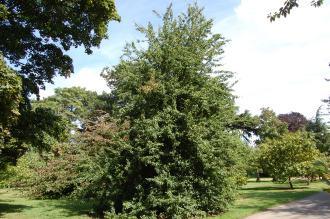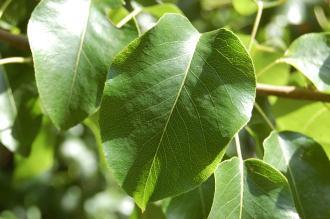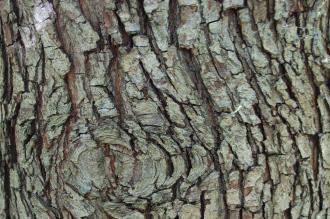
Pyrus pyraster (15/08/15, Kew Gardens, London)
Position: Full sun to partial shade
Soil: Moist, well drained
Flowering period: Early spring
Eventual Height: 12m
Eventual Spread: 12m
Hardiness: 5a, 5b, 6a, 6b, 7a, 7b, 8a, 8b, 9a
Family: Rosaceae
Pyrus pyraster is a deciduous tree with a conical habit becoming more rounded as it matures. Its mid green leaves are elliptic with serrulate margins, up to 8cm long and 4cm across. Its leaves become orange/ red in Autumn before they fall. Its gray bark is deeply fissured and plated. Its white / pink hermaphroditic flowers are borne in corymbs. Its brown/ green fruit is a hard pomme and up to 35mm across. Its roots are fibrous with a deep tap root.

Pyrus pyraster Leaf (15/08/15, Kew Gardens, London)
Pyrus pyraster, commonly known as Wild Pear, is native to central and eastern Europe. In its native habitat it grows in very dry rocky locations as well as wet woodland edges where it can out compete other plants in extreme conditions.
The etymological root of the binomial name Pyrus is the classical name for the pear tree. Pyraster is from the Latin piris meaning ‘pear tree’ and -aster meaning ‘somewhat similar’.
The landscape architect may find Pyrus pyraster useful as a small, flowering specimen tree which is attractive to wildlife. This tree is tolerant of atmospheric pollution.

Pyrus pyraster Bark (15/08/15, Kew Gardens, London)
Ecologically, Pyrus pyraster flowers are attractive to pollinating insects. Its fruit is attractive to birds and mammals.
Pyrus pyraster prefers moist, fertile, well-drained soils. It tolerates most pH of soil.
Pyrus pyraster will require different methods of pruning depending on the stock used as well as how it is grown. Useful tips on the care of pear trees can be found in this Pear Growing Guide.

Landscape Architecture

